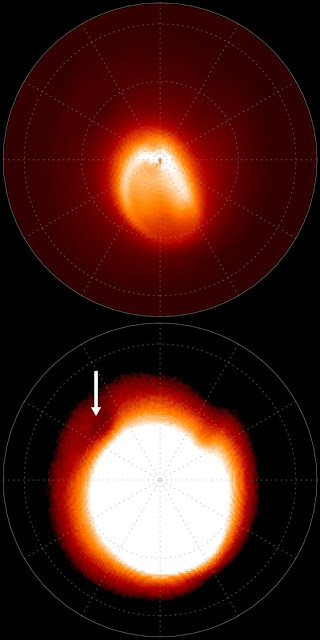

| Online: | |
| Visits: | |
| Stories: |

| Story Views | |
| Now: | |
| Last Hour: | |
| Last 24 Hours: | |
| Total: | |
How Jupiter’s Great Cold Spot Changes Dramatically in Shape and Size, Rivals Great Red Spot
Dubbed the ‘Great Cold Spot’, it has been observed as a localised dark spot, up to 24,000 km in longitude and 12,000 km in latitude, in the gas giant’s thin high-altitude thermosphere, that is around 200K (Kelvin) cooler than the surrounding atmosphere, which can range in temperature between 700K (426ºC) and 1000K (726ºC).
The results are published today (11 April) in Geophysical Research Letters.
Dr Tom Stallard, Associate Professor in Planetary Astronomy and lead author of the study, said: “This is the first time any weather feature in Jupiter’s upper atmosphere has been observed away from the planet’s bright aurorae.
“The Great Cold Spot is much more volatile than the slowly changing Great Red Spot, changing dramatically in shape and size over only a few days and weeks, but it has re-appeared for as long as we have data to search for it, for over 15 years. That suggests that it continually reforms itself, and as a result it might be as old as the aurorae that form it – perhaps many thousands of years old.”
The Great Cold Spot is thought to be caused by the effects of the magnetic field of the planet, with the massive planet’s spectacular polar aurorae driving energy into the atmosphere in the form of heat flowing around the planet.
This is a map of the north hemisphere of Jupiter’s ionosphere, added up over 13,000 images, and more than 40 nights. In the top image, the aurora is clearly seen, but only once the aurora is saturated can the non-auroral emission be removed. This reveals that the Great Cold Spot can be seen as a continuously observed feature over the entire six years of the IRTF observing campaign – which started more than 15 years before the VLT observation.

Credit: Based on data from IRTF/NASA.
This creates a region of cooling in the thermosphere, the boundary layer between the underlying atmosphere and the vacuum of space. Although we can’t be sure what drives this weather feature, a sustained cooling is very likely to drive a vortex similar to the Great Red Spot.
The Great Cold Spot was first discovered on Jupiter using observations taken of Jupiter’s auroral region by the CRIRES instrument on ESO’s Very Large Telescope. The images on the left show the bright arcs of Jupiter’s infrared aurora on two separate nights, the top left image on 17 October and three images taken 31 December 2012, as the planet slowly rotates. However, the Great Cold Spot cannot be seen clearly until these images are saturated so that the entire aurora becomes white, as shown on the right. Here, the planet glows as a result of the temperature of the upper atmosphere, and the distinct regions of cooling that reveal the Great Cold Spot can be seen.

Credit: Based on data from VLT/ESO.
Dr Stallard, who is funded by the Science and Technology Facilities Council, added: “What is surprising at Jupiter is that, unlike weather systems on Earth, the Great Cold Spot has been observed at the same place across 15 years. That makes it more comparable to weather systems in Jupiter’s lower atmosphere, like the Great Red Spot.
“Observations and modelling of Earth’s upper atmosphere have shown that, on the short term, there may be changes in the temperature and density of the upper atmosphere.
“The two main differences are firstly that Earth’s aurora sees dramatic changes caused by activity from the Sun, whereas Jupiter’s aurora are dominated by gases from the volcanic moon Io, which are relatively slow and steady, and secondly that the atmospheric flows generated by Earth’s aurora can drive heat quickly across the whole planet, making the upper atmosphere ring like a bell, while Jupiter’s fast spin traps this energy nearer the poles.”
This image shows how the Great Cold Spot changes dramatically in shape and size on different days. Each view comes from a different day, with the spot sometimes almost disappearing. Because the feature is dynamic, changing over both daily and yearly timescales, it is likely that this feature is a weather system that is in a constant state of change. But despite this variability, it is seen again fifteen years later, showing it must reform again and again.

Credit: Based on data from IRTF/NASA.
“The Juno spacecraft is currently in orbit around Jupiter and the observations of Jupiter’s aurora and upper atmosphere by the JIRAM instrument that have been released so far already provide a wealth of new information about the planet. When combined with our ongoing campaign of observations using telescopes on Earth, we hope to gain a much better understanding of this weather system in the next few years.”
Tom Stallard


